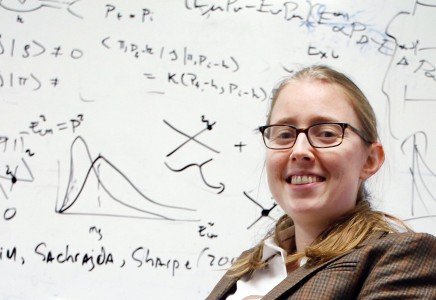
Phiala Shanahan theorizes that gluons have an effect on the structure of the nucleus.
A Problem-Solver Breaking through Barriers
Phiala Shanahan loves having problems to solve—and a team to collaborate with on her quest to prove her theories. Though she is one of the newest senior scientists at Jefferson Lab, Shanahan already has identified and developed a plan for how she might help solve one of the biggest problems facing nuclear physicists: the true structure of strong forces within the nucleus. Now it’s up to her team of collaborators to prove her theory.
As a theoretical physicist, Shanahan spends a good deal of her time at her computer studying the strong forces of gluons. She writes complex computer codes for simulations that she then runs through Jefferson Lab’s SciPhi-XVI supercomputer. Based on those simulations, Shanahan has developed potentially groundbreaking theories about gluonic effects.
“What I’ve been doing is trying to explain the structure of nuclei from fundamental physics principles,” Shanahan explains. “We all learn that a nucleus is made up of a bunch of protons and neutrons. That’s based on empirical observation. Our theory tells us that, really, it’s made up of quarks and gluons, because protons and neutrons are made of quarks and gluons.”
A Measurable Gluonic Effect
Shanahan notes that the idea of a gluonic effect was first proposed in 1989—before she was born. Yet, now, says Shanahan, gluonic effects are potentially experimentally measurable and also calculable from fundamental theories, thanks, in part, to faster supercomputers that enable complicated calculations.
“Before, we weren’t at a stage where these effects could be calculated or measured. Now, we’re at a point where they might actually be measured from experiment,” she says. “Calculating them from theory involves supercomputer calculations, and writing code to do this is highly nontrivial. We’re only just reaching a point where our computing power is sufficient.”
Shanahan is particularly excited by a result that came out in September. “I did a calculation that shows for the first time that a nucleus has gluonic effects that are not just the effects you’d have from a collection of protons and neutrons,” she says. “These are non-nucleonic glue effects in a nucleus. The reason this is super-exciting is that this is not an effect that is in most of our models of nuclear structure at this point in time. It’s something new.”
Moreover, with the completion of Jefferson Lab’s 12 GeV Upgrade project, scientists are able to delve into the mysteries of matter in the universe deeper than ever before. Further measurement would be possible through the use of a proposed high-energy, high-luminosity polarized Electron-Ion Collider, or EIC.
“It may be possible to test this prediction experimentally within the next five to ten years,” says Shanahan. “This is exciting, because it’s a new effect—we have a concrete prediction for it—and we will be able to measure it using the new experiments. We will know whether our prediction matches the universe or not.”
Experimenting with Collaborators
As a theoretical physicist, Shanahan relies on her experimental physicist collaborators to develop experiments to test her theories. “It’s not exciting if I understand something from theory that we’re never going to be able to measure experimentally,” says Shanahan. “To really be able to have an answer, you need a theory and an experiment.”
While Shanahan waits for an electron-ion collider to be built, she has been cultivating a team of collaborators that will help her test the theory. They meet regularly to discuss the experiment, often for week-long work retreats where they work nearly around-the-clock planning and discussing ongoing research across the field that contributes to their problem-at-hand.
How do Shanahan and her collaborators go about preparing for an experiment that could be years away? “First, you need to work out what’s interesting and then you need to work out how to do it,” explains Shanahan. “Knowing what’s interesting comes down to knowing the state of the field—knowing where that cutting-edge of science is and where the little dark corners are where we don’t quite have a complete understanding, but that might lead to something interesting.”
Problem Solving Outside of the Lab
For Shanahan, the enjoyment of working out solutions to complex problems transcends her work at the lab. She is also a devout rock-climber, a hobby she says she shares with many of her scientist colleagues, including her husband. “There seem to be quite a large number of scientists who also rock climb,” she says. “And there are a lot of excellent musicians.”
Shanahan and her husband are building a 16-foot bouldering cave in their back yard. As for being a musician, Shanahan played in a cover band throughout college, specializing in “classic party music.” She plays saxophone, clarinet, piano and guitar. Just like in the lab, Shanahan is well-versed in the art of focusing on her craft, then combining efforts with collaborators to make something new.
Though Phiala Shanahan is only 26, the Australia native has already been a postdoctoral research associate at the Massachusetts Institute of Technology, earned the 2016 American Physical Society Dissertation Award in Hadronic Physics and landed an assistant professorship at the College of William & Mary. She has also been named by Forbes Magazine as one of their “Top 30 under 30” recipients in the 2017 science category.
December 2017

